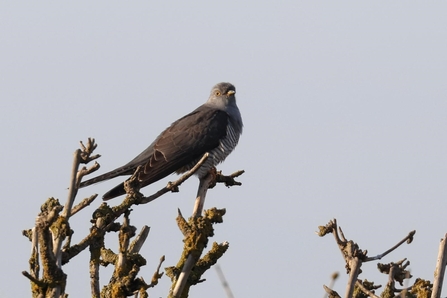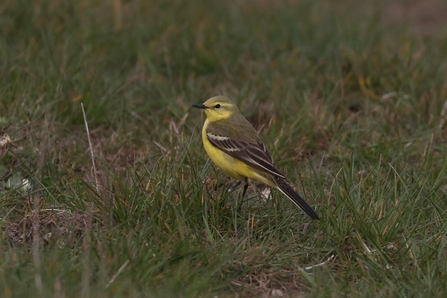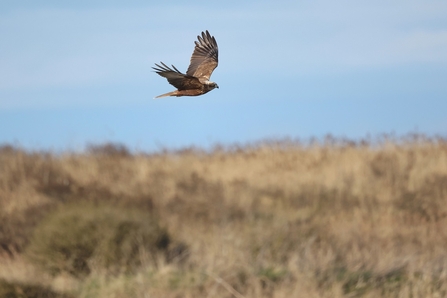A flood of spring migrants occurred mid-month with the first: avocet (14th), greenshank (18th), little ringed plover (13th), sedge warbler (13th), reed warbler (15th), grasshopper warbler (13th), whitethroat (13th), lesser whitethroat (15th), blackcap (13th), garden warbler (28th), cuckoo (18th), swallow (13th), sand martin (15th), house martin (16th), tree pipit (13th), wheatear (13th) and yellow wagtail (13th). By the end of the month summer migrants, particularly warblers, had truly arrived on mass, a survey from Chapel Six Marshes to Anderby Creek producing 43 sedge warbler, 10 reed warbler, 12 blackcap, 20 willow warbler, 16 chiffchaff and 12 whitethroat.
Lincolnshire Coastal Country Park - April 2022
Shoveler over Anderby Marsh © Garry Wright

Cuckoo - it's been an excellent spring for cuckoo with up to six birds present around Anderby Creek on a daily basis (Garry Wright)
At least two bearded tits were present at Huttoft Pit earlier in the month with no subsequent sightings thereafter.
Anderby Marsh peak counts during the month were three garganey (pair on the 1st and a female on the 19th), 164 teal, 5 shelduck, 30 wigeon, a drake red-breasted merganser (6th), 7 tufted duck, 34 shoveler, 55 gadwall, 6 little egret, 2 avocet (14th), little ringed plover, 2 ringed plover, 4 ruff (7th), 2 lapwing, turnstone, 62 black-tailed godwit, 6 redshank, 8 curlew, 5 whimbrel, 2 dunlin and 3 snipe. A short-eared owl was also seen quartering over the marsh on the 14th. The majority of winter wildfowl (wigeon and teal) had left the marsh by the end of April. Water levels have been slowly dropping due to the drought experienced later in the month, this has resulted in some nice muddy edges on the marsh, providing excellent feeding opportunities for wading birds.
Rare and scarce species included; a hooded crow south on 8th, a singing Siberian chiffchaff (very unusual to hear in the UK) on the 11th at Wolla Bank, a wryneck on the 29th north of Marsh Yard and a spoonbill on Anderby Marsh on the 26th. A few red kites were again recorded migrating through the area with singles noted on three dates.

Yellow wagtail – a lovely adult male bird on Anderby Marsh (Garry Wright)
A bittern was seen in flight over Chapel Six Marshes on 14th April and again over Wolla Bank on the 17th. This is the first bird to be seen in spring for a number of years which is quite encouraging to see.
Some winter migrants remained during the month with singles of fieldfare and redwing recorded at Huttoft Pit on the 16th, at least four jack snipe with 10 snipe on the 14th and a water pipit on Anderby Marsh on the 13th and 17th.
Sea-watching on the 19th produced two adult little gull and singles of Manx shearwater, fulmar, razorbill and red-throated diver.
At least 2-3 pairs of marsh harrier are currently in residence and settling down for the breeding season. In addition to this, at least 14 singing Cetti’s warbler have been noted throughout the Lincolnshire Coastal Country Park!

Marsh harrier - there are up to three pairs now on established territories (Garry Wright)
Non-avian highlights
A survey of green-winged orchids at a site near Anderby village produced an incredible 11,331 spikes (flowering plants).
Daily records of between one and three harbour porpoises from the 14th-30th at Anderby Creek. Sightings almost guaranteed on calm days with some patience especially early morning.
After a cold March many butterflies were seen on the wing during April including green hairstreak (from the 26th), peacock, small tortoiseshell, comma, red admiral, green-veined white, orange-tip, small white, speckled wood and holly blue.
Boxing brown hares on farmland throughout from mid-month. Foxes also noted on the 9th from Anderby Creek and Huttoft Pit.
An impressive grass snake measuring almost four feet in length was recorded at Huttoft Pit at the end of the month.

Green-winged orchid (Richard Doan)
Top five species - May
Green Hairstreak – look out for these ‘little green gems’ along the coastal path particularly between Wolla Bank and Anderby Creek from mid-morning (after 10am). They are often seen feeding on the Hawthorn and Elder trees.
Avocet – keep an eye on the Anderby Marsh for sightings of avocet, they have always been scarce birds in the Lincolnshire Coastal Country Park, however, now the marsh has been flooded it is hoped that they may become a regular feature during the summer months.
Hairy Dragonfly – these lovely dragonflies are now seen regularly in spring having only colonised the area in recent years. Fine days with plentiful sunshine is essential for sighting. The areas south of Anderby Creek often produce the majority of sightings.
Sandwich Tern – although breeding in North Norfolk there are regular sightings of birds offshore in May. Listen out for their distinctive scratchy calls which often draw attention.
Whitethroat – despite being only a summer visitor the whitethroat is one of the most common birds present in the dunes. At this time of year birds are often observed atop the scrub singing away to attract a mate for the upcoming breeding season.

